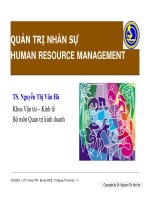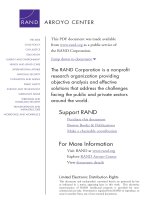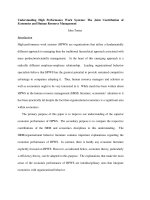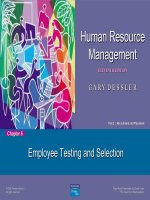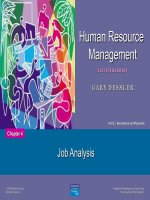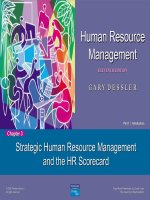Human resource management research at vietnam mobile telecom services one member limited liability company
Bạn đang xem bản rút gọn của tài liệu. Xem và tải ngay bản đầy đủ của tài liệu tại đây (1.27 MB, 106 trang )
ĐẠI HỌC QUỐC GIA HÀ NỘI
KHOA QUẢN TRỊ VÀ KINH DOANH
---------------------
TRẦN THỊ DUNG
HUMAN RESOURCE MANAGEMENT RESEARCH AT
VIETNAM MOBILE TELECOM SERVICES ONE MEMBER
LIMITED LIABILITY COMPANY
NGHIÊN CỨU HOẠT ĐỘNG QUẢN TRỊ NGUỒN NHÂN LỰC
TẠI TỔNG CÔNG TY VIỄN THÔNG MOBIFONE
LUẬN VĂN THẠC SĨ QUẢN TRỊ KINH DOANH
HÀ NỘI - 2019
ĐẠI HỌC QUỐC GIA HÀ NỘI
KHOA QUẢN TRỊ VÀ KINH DOANH
---------------------
TRẦN THỊ DUNG
HUMAN RESOURCE MANAGEMENT RESEARCH AT
VIETNAM MOBILE TELECOM SERVICES ONE MEMBER
LIMITED LIABILITY COMPANY
NGHIÊN CỨU HOẠT ĐỘNG QUẢN TRỊ NGUỒN NHÂN LỰC
TẠI TỔNG CÔNG TY VIỄN THÔNG MOBIFONE
Chuyên ngành: Quản trị kinh doanh
Mã số: 60 34 01 02
LUẬN VĂN THẠC SĨ QUẢN TRỊ KINH DOANH
NGƯỜI HƯỚNG DẪN KHOA HỌC: PGS.TS. NGUYỄN NGỌC THẮNG
HÀ NỘI - 2019
CAMPAIGNS
I pledge that this is my own research. The content referenced and used the
documents, information posted on the works, journals and reports are fully
annotated in the catalog reference of thesis.
Author
Tran Thi Dung
i
THANK YOU
First of all, I would like to thank the Faculty of Management and
Businessment, Hanoi National University, especially the teachers have taught
heartily, guide, help me throughout the time studying in the Faculty.
I would like to send my deep thanks to Assoc. Prof. Dr. Nguyen Ngoc Thang
who spent a lot of time and dedication on studying and helping me to
complete graduation essay
I sincerely thank my colleagues, friends and relatives for their help,
encouragement, motivation during my studying process and doing my
graduation essay.
Author
Tran Thi Dung
ii
TABLE OF CONTENTS
CAMPAIGNS .................................................................................................... i
THANK YOU ................................................................................................... ii
LIST OF ABBREVIATIONS .......................................................................... vi
LIST OF TABLES .......................................................................................... vii
LIST OF PICTURES ..................................................................................... viii
PREAMBLE...................................................................................................... 1
Chapter 1: THEORETICAL AND PRACTICAL FOUNDATION OF
HUMAN RESOURCES MANAGEMENT IN ENTERPRISES ..................... 7
1.1. Theoretical foundation of human resource management in enterprises ......... 7
1.1.1. Concept of human resources and human resources ............................. 7
1.1.2. The concept, goal and role of human resource management .............. 7
1.1.3. Content management of human resources in the enterprise .............. 11
1.2. Practical basis of human resource management in enterprises ................ 20
1.2.1. Experiences in human resource management of some enterprises in
the field of telecommunications ................................................................... 20
1.2.2. Lessons learned on human resource management for the General
MobiFone Telecom ...................................................................................... 25
Chapter 2: SITUATION OF HUMAN RESOURCES MANAGEMENT AT
MOBIFONE TELECOMMUNICATIONS CORPORATION ...................... 26
2.1. Some general information about MobiFone Corporation ........................ 26
2.1.1. The process of formation and development ....................................... 26
2.1.2. Business line of MobiFone Telecom Corporation ............................. 28
2.1.3. Organizational structure of MobiFone Corporation .......................... 28
2.1.4. Human resources in MobiFone's staff ............................................... 31
2.1.4. Employees of MobiFone Staff ........................................................... 31
iii
2.2. Current situation of human resource management in the MobiFone
Telecom Corporation ...................................................................................... 35
2.2.1. Situation of human resource planning ............................................... 35
2.2.3. Situation of labor recruitment ............................................................ 39
2.2.4. Status of training and development ................................................... 43
2.2.5. Current status of compensation and compensation ........................... 51
2.2.6. Situation of labor relations ................................................................. 56
2.3. General assessment of human resource management in MobiFone ........ 60
2.3.1. Advantages ......................................................................................... 60
2.3.2. The remaining aspects, limitations .................................................... 62
2.3.3. Cause of the shortcomings ................................................................. 64
Chapter 3: SOLUTION TO COMPLETE THE MANAGEMENT OF HUMAN
RESOURCES IN MOBIFONE TELECOMMUNICATIONS CORPORATION 66
3.1. Development orientation of MobiFone Telecom Corporation in the
coming time ..................................................................................................... 66
3.1.1. Necessity and requirements for human resource management of
MobiFone in the coming time ...................................................................... 66
3.1.2. Development orientation of MobiFone in the coming time .............. 67
3.1.3. The goal of improving human resource management at MobiFone .. 67
3.2. Complete solution of human resource management at MobiFone Telecom
Corporation...................................................................................................... 68
3.2.1. Complete human resource planning .................................................. 68
3.2.2. Complete recruitment of human resources ........................................ 70
3.2.3. Develop a process for performance appraisal and periodic appraisal of
performance.................................................................................................. 73
3.2.4. Carry out the training and development of human resources ............ 77
3.2.5. Ensure benefits and benefits for employees ...................................... 81
CONCLUDE ................................................................................................... 85
iv
LIST OF REFERENCES ................................................................................ 87
APPENDIX ..................................................................................................... 89
v
LIST OF ABBREVIATIONS
STT Abbreviation
Original
1
BM
Business Manufacture
2
E
Enterprise
3
E–S
Economy – Social
4
FA
Fixed assets
5
H
Human
6
HR
Human resoureces
7
HRM
Human Resource Management
8
I-M
Industrialization – Modernization
9
J
Job
10
JSC
Joint Stock Company
11
Ltd.,
Limited
12
MOBIFONE
MOBIFONE Telecommunications Corporation
13
P’s C
People's Committee
14
SC
State capital
15
SCM
State capital management
16
SE
State enterprises
17
T –F
Training and fostering
vi
LIST OF TABLES
Table 2.1: Human resources characteristics of the Vietnam Cooperative
Alliance (at the Advisory Board) .................................................................... 33
Table 2.2: Age structure of MobiFone employees in 2017 (The Advisory Board) .. 34
Table 2.3: Number of staff surveyed for work Human resource planning ..... 36
Table 2.4: Staff Evaluation on Human Resource Planning ............................ 37
Table 2.5: Evaluation of staff on planning, job analysis ................................ 38
Table 2.6: Employment situation at MobiFone .............................................. 39
Table 2.7: Evaluation of staff on labor recruitment ........................................ 43
Table 2.8: Staff were sent for training and trainin in the period of 2015 - 2017 ... 44
Table 2.9: Responsibility of staff after training .............................................. 47
Table 2.10: Personnel structure according to seniority ................................... 48
Table 2.11: Evaluation of staff on training and human resource development .... 50
Table 2.12: Average income of MobiFone employees ................................... 52
Table 2.13: Evaluation of staff, salary and benefits........................................ 54
Table 2.14: Survey staff and employees on benefits deserved ....................... 55
Table 2.15: Survey staff and employees on the benefits of MobiFone need
improvement.................................................................................................... 55
Table 2.16: Evaluation of staff on labor relations........................................... 57
Table 2.17: Evaluation of staff, management staff ......................................... 58
Table 3.1: Performance assessment for MobiFone staff................................. 76
vii
LIST OF PICTURES
Image 2.1. MobiFone's organizational structure ............................................. 31
Figure 2.1. Organizational structure of MobiFone ......................................... 31
Figure 2.2: Staff performance assessment chart about labor recruitment of
MobiFone ........................................................................................................ 43
Figure 2.3: Chart of evaluation result of staff on training work and human
resource development...................................................................................... 50
viii
PREAMBLE
1. The urgency of the topic
In the present stage of development, together with the strong
development of science and technology and the integration of the global
economy, organizations and businesses to achieve high efficiency in the
production process of his business, it must acknowledge the role of human
resource management (HRM). Problem is put in an constantly fluctuate
environment, but has many opportunities challenge now is how to turn the
human resource (HM) of the organization into a weapon strong enough in
both quantity and quality as well as having certain flexibility to maintain and
develop the team's activity organizations, enterprises. However, to use HR
effectively is not a simple problem. It requires leaders, managers to have a
look throughout, grasp the nature, content issues as well as doctrine, tissue
Management to find out for businesses, organize a suitable plan with
their characteristics and conditions, they can develop to their full potential and
potential human resources.
Today, in the process of innovation and development, human resource
is an important factor that determines success and failure, therefore,
sustainable development of a country, a locality or a business. In the HRM,
the most important thing is how to maintain, encourage and motivate
employees to work their way with excitement. So, to lead the staff
successfully, want them peace of mind, enthusiastically work, managers must
know how to motivate them. Recruitment, training, salary, equitable treatment
and science are the greatest incentives for labor in the current period. But in
the long term, non-material stimulus such as the work itself, the working
environment is a great source of encouragement that help mployees relaxed,
promoted, enthusiastic and satisfied with their work. So the Human resource
1
management issues of organizations and enterprises in the current stage need
to be concerned and invested in the right way and in time.
Over the years, MOBIFONE Telecommunications Corporation has
changes in the development of human resources policy in line with the
development trend of socio-economic, suitable for the requirements of the
competitive situation, the trend of transfer of telecommunication services,
although always received the appreciation of the leaders of the corporation
about the corporation's achievements in business as well as personnel policies
However, human resource management in the corporation still should
be studied to evaluate achievements, The existence and cause, on that basis,
propose solutions to constantly strengthening and improving in the coming
time. Set in that context, research topic is necessary, meaningful both
theoretical and practical. From those reasons I chose the subject "Research on
Human
Resource
Management
in
MOBIFONE
Telecommunication
Corporation "as a graduate thesis topic.
2. Overview of research situation
Research on human resources and human resources management is
very many kinds of books, essays and newspapers talk about this issue:
- A Handbook for Effective Management, Human Resource
Management by Robert Heller, translator: Lê Ngọc Phương Anh. With
content talking about the basic elements of the successful management
techniques allow you to advise employees to work with their best. The book
also shows how management can turn failures to success for the company, by
identifying and avoiding spectrum problems. In addition to practical tips, the
book also offers 101 helpful hints and a self-assessment of self.
- Human resource curriculum written by Nguyen Huu Than with the
content of human resources management activities, providing the theory of
human in the most comprehensive way.
2
- Tran Kim Dung with the article "The Impact of Human Resource
Management Practices on the Performance of Small and Medium Enterprises"
published in the Economic development magazine in 2006 No. 189, p. 40-42.
Let us take an overview of the reality of human resources management
activities of small and medium enterprises and
give some directional
solutions for businesses.
In addition to the book, there are some essays on human resource
management such as the thesis of Nguyen Tuan Dung with the content
"Completing the Human Resource Management at School Hotel" in 2008, the
thesis gave the theoretical and practical comment on management practices at
School Hotel. The author analyzes and evaluates the status of human resource
management through evaluating the capacity of personnel planning, job
analysis and performance as well as personnel selection of the hotel. From
assessing the advantages and limitations of the author has given some
solutions to help improve the management of the hotel.
- Essay of Nguyen Ngoc Linh with subject "Human Resource
Management in General
Northern Food Corporation "in 2017 has systematized the rationale and
Build solutions to help businesses achieve better performance in the
operation
Human resource management, in the author's thesis also uses a variety
of models
to assess the performance of the staff management of the corporation. Nguyen Ngoc Linh's thesis "Human Resource Management in the Northern
Food Corporation" in 2017 has systematized the theoretical basis and
developed solutions to help businesses achieve better performance. In human
resource management, the author also used many quantitative models to
evaluate the performance of human resource management of the corporation.
3
- Le Thi My Linh (2009) with the topic "Development of human
resources in small and medium enterprises in Vietnam in the process of
economic integration". The topic has systematized and developed theories on
human resource development in general and has provided a general model of
the content, approach and approach of human resource development in small
and medium enterprises. fit. Based on that, the topic has collected
information, explored and analyzed the real situation of human resource
development in small and medium enterprises, showing the remaining aspects
of this work. Based on analyzes and assessments, the thesis has proposed a
number of views, solutions and recommendations for the development of
human resources in small and medium enterprises in Vietnam.
These studies have contributed to the systematization of theories and
analysis of general issues of human resource management in economic
organizations in Vietnam in general and in enterprises with capital of the State
or Private enterprise in particular. However, before the changes in the domestic
and foreign economic situation are posing many issues that need to be
discussed not only at the macro level of human resource management but also
in both private and public enterprises. government. However, the books only
studied in general, and for the dissertation, only the methodology of evaluating
the effectiveness of personnel management and solution of specific areas of
research, not a single. Which comprehensive research and evaluation of human
resources management activities at MOBIFONE Telecommunications
Corporation. Therefore, this is still the missing content and students want to
discuss research.
3. Objectives of the study
Clarify the current reality of human resources management of the
Corporation
4
MOBIFONE through the activities: human resource planning, public
analysis job; recruiting, using, training, developing and remuneration system ...
On that basis the subject offers a number of solutions to promote and improve
the human resources management of the Corporation in the coming time.
4. Research objects
The subject of the thesis is human resource management of MOBIFONE
Telecommunications Corporation.
5. Scope of research
- Content: Study the contents of human resource management of
MOBIFONE Telecommunications Corporation.
- Regarding space: Research at the General Staff Unit MOBIFONE
Telecommunication Corporation.
- Time: 2015 - 2017
6. Research Methodology
- Logical, historical, statistical methods.
- Secondary Document Analysis Methodology: The material to be
analyzed includes: the data, parameters are taken from the MOBIFONE
Telecommunications Corporation and the journal articles, reports, scientific
research works.
- Survey Methodology: To collect primary data, the learner designs the
set of questionnaire survey and sent to 500 staff at MOBIFONE via e-mail.
As a result, the trainee collects 450 vouchers with enough information for
serving dissertation.
The questionnaire consists of the following sections: Information on
interviewees and questions related to human resource management at
MOBIFONE (Human resource activities, job analysis, recruitment, training;
compensation policy and treatment; labor relations)
Details of the survey questionnaire are attached as Annex 1.
5
- Interviewing method: The interview method is used for collecting
more information on the production and business of the Corporation, the
policies and solutions to improve human resource management in
MOBIFONE Telecom. In this study, the trainees chose to interview 20
people, focusing on the subjects: Heads, Deputy Directors, units of the
Group's staff.
The list of interview questions is attached in Attachment 2.
- Data processing method: Excel software
6
Chapter 1
THEORETICAL AND PRACTICAL FOUNDATION OF HUMAN
RESOURCES MANAGEMENT IN ENTERPRISES
1.1. Theoretical foundation of human resource management in enterprises
1.1.1. Concept of human resources and human resources
Human resources are understood as the resources of every human being
that this resource including physical strength and intellect. Manpower has
great influence on management level and the level of use of business factors,
human resources is a dynamic factor, positive of each production process.
Human resources are all individuals involved in any activity of
organizations, enterprises, to achieve the achievements of organizations,
businesses that set out. Any organization made up of members is human
resources. Human resources are different from the businesses resources
(finance, capital, equipment, etc.) that are The most precious and most
important resources in all organizations, enterprises. Therefore, it can be said
that human resources of an organization include all employees working in that
organization.
Human resources as a factor of socio-economic development are labor
capacity of the society is understood in a narrower sense, including the
population in working age are able to work.
So, "human resources can also be understood as the synthesis of
individual beings people involved in the process of labor, is the overall
physical and mental factors in the process of labor".
1.1.2. The concept, goal and role of human resource management
1.1.2.1. The concept of human resource management
There are many ways of understanding about human resource
management (HRM). The concept of HRM can be presented in many
7
different perspectives. HRM is one of the important mission of leading
businesses, it determines survival and development of the business. HRM
covers both broad and narrow meanings.
In broad terms: HRM is the process of exploiting, organizing and using
science modern techniques and management theories to achieve team
strategic goals by regularly search, human resources development,
coordination, inspect and urge the implementation of the rational wage and
penalty regime exploit and utilize effectively human resources [11].
In a narrow sense: HRM is the process by which the regulator
implements these specific tasks such as recruiting, reviewing, assigning work,
solving salary and allowance, evaluating staff quality, performance goals and
plans of the organization well.
Thus, human resource management is a process of recruitment,
selection, maintain, develop, use, encourage and provide facilities for human
resources through that organization.
Can be understood in a simple and short way: HRM is the way that
makes employees work effectively and is pleased with their work.
From a management perspective, mining and human resource
development focus on value of people, exploit and manage to address these
interpersonal interaction with work, between employees and employees,
between employees and the organization. Exploitation and management of
human resources needs to be achieved the result enhances the performance of
the organization, enhancing competitiveness. On the other hand, improving
the lives of employees makes them feel comfortable and stick with task.
But in any sense, HRM is still all the activities of a team to build,
develop, use, evaluate, preserve a work force in accordance with the
organization's work requirements both in terms of quality and quantity. The
objects of the HRM are workers as individuals, officials and employees in the
8
organization and related issues such as their work and their rights and
obligations in the organization.
The basic goal of any organization is to use HRM effectively to achieve
the goals of that organization. Human Resource Management is to strengthen
and maintain sufficient quantity and quality of
labor to achieve the
organizational goals.
1.1.2.2. Human resource management objectives
The basic objective of a business is to attract good people with the
business, use human resources effectively to increase productivity and
improve the efficiency of enterprises and motivating employees, enabling
them to express, develop, and devote, help them stick together, athusiastic,
loyal to the business.
Social Objectives: In terms of social aspects, human resource
management presents a very humanist perspective on the rights of workers,
enhancing the position and values of workers, attaching importance to
harmonious settlement of interests. Benefit sharing between organizations,
enterprises and employees.
The goal of the organization is to provide personnel so that each
department accomplishes its own goals and tasks in line with the overall goals
of the organization. It is the construction of the structure and organization of
personnel corresponding to the structure of operation of that organization and
the criteria for measuring the performance of the enterprise: gross profit;
Profit margin; Profit per unit of product (service); Fixed payback period;
Working capital turnover; Labor productivity; Average income.Personal
goals: This is an important goal because it meets the goal
Personal goals: This is an important goal because meeting the individual
goals of the employee will motivate their efforts, to accomplish the task most
effectively, which will lead to the success of the organization. In addition,
9
personal goals should also answer the question: "What do employees need at the
manager?". They need: Stable employment; Evaluate the capacity, the right
contribution; Be treated fairly; Promising in work, income; Safety at work.
1.1.2.3. The role of human resource management
Any business that conducts business activities must meet two factors,
human and material. In particular, human resources play an extremely
important role, decisive for the existence and development of enterprises.
Firstly, due to the increasing competition in the market, businesses that want
to survive and develop are forced to improve their organizations in a compact,
dynamic way in which the human factor is decision. People with their skills,
qualifications, use of labor tools affect the labor object to create products for
society. This process is also organized and controlled by humans. People design and
produce goods and services, check quality, sell products on the market, allocate
financial resources, define common strategies and goals for the organization.
Without effective people, every organization can not achieve its goals.
Secondly, the advancement of science and technology together with the
economic development forces the executives to know how to adapt their
organization. Therefore, the implementation of the planning, recruitment,
retention, development, training, motivation and creation of favorable
conditions for human beings through the organization, in order to achieve the
set objectives. top concern.
Thirdly, human resources management research helps managers
achieve goals and outcomes through others. An administrator can plan a
complete, clear organizational map with an accurate modern inspection
system, but the manager can fail if he or she does not know the right person
for the job, or do not know how to encourage employees to work. To be
effective, managers need to know how to work and get along with others, and
how to engage others.
10
Fourthly, human resource management helps managers learn how to
deal with others, find common language and be sensitive to the needs of
employees, and know how to evaluate employees accurately. . They have to
entice employees into the job, avoid mistakes in the selection, use staff, know
how to coordinate the goals of the organization and the goals of individuals,
improve efficiency organization's. Businesses need to put human strategy into
a strategic part of business, contributing to improve the quality and efficiency
of the organization.
In summary, human resource management plays a central role in the
process of running a business enterprise in general, helping businesses
survive, grow and rise in competition. This central role comes from the role of
the human being: the human being is the constituent element of the enterprise;
Human beings operate the business and the people decide the success of the
business. Because of the important role of NNL, human resource management
is an important management area in every business.
1.1.3. Content management of human resources in the enterprise
1.1.3.1. Human Resource Planning
Human resource planning is the process of forecasting, identifying
human resource needs, setting policies and skills and qualities necessary for
each stage of operation and bringing about high efficiency for the
organization.
Human resource planning plays a central role in human resource
management, having a great influence on the efficiency of the work of the
enterprise. Therefore, human resource planning contributes to the success of
the business. Human resource planning helps businesses proactively
anticipate personnel changes, from which adjustments are made. From then
on, the business will know what kind of employees? When do businesses
need them? Does the company already have the right person? Human
11
resource planning is the basis for recruiting, training, developing and
maintaining human resources. It affects the efficiency of the business. Good
human resource development will help the company to have the right
personnel. When there is no human resource planning or ineffective human
resource planning, the enterprise will not be able to evaluate its human
resources. This greatly affects the overall performance of the business.
Human resource planning also creates an opportunity for enterprises to be
proactive in human resources. Ensure that the business always has enough staff
with the necessary skills at the right time. At the same time, avoid the risk of using
labor and help administrators clearly identify the direction of the organization.
1.1.3.2. Job analysis
Job analysis is the process of studying job content in order to determine
the conditions of work, duties, responsibilities and authority when performing
the work and the qualities and skills required. to perform well assigned tasks.
Job analysis also collects systematic information about the work. Job analysis
is designed to identify tasks that fall within a specific area of work and to
identify the specific skills, capabilities, and responsibilities of the personnel
that the job requires to be successful.
Job analysis provides managers with a summary of the tasks and
responsibilities of a job with other jobs, skills and working conditions. Job
analysis is performed in the following three cases
First: When the organization is established and the job analysis
program was conducted for the first time.
Second: When new work is needed.
Third: When the work must change as a result of new science and
technology, methods, procedures or new systems.
1.1.3.3. Recruitment
Employing a job is a process of attracting, researching, selecting and
deciding to get an individual into an organization. The purpose of the
12
recruitment is to select one or more candidates from the selection criteria that
best matches the criteria and requirements of the position.
The requirements for recruiting employees into organizations are:
- Recruiting qualified and suitable people to work in high productivity
and good work.
- Recruiting disciplined people who are ethical and know how to stick
with the work of the organization.
- Recruiting people with good health and long-term ability. By
recruiting new employees, one side of the workforce is rejuvenated and the
other average level is increased. So one can say that "recruiting employees is
a form of non-physical investment, investing in people"
The recruitment process consists of the following steps:
- Step 1: Identify needs.
Demand can be anticipated (when creating a new organization and new
positions, having retirement arrangements, promotion or transfer known)
Unforeseen needs (sickness, sudden illness, accident or death, absence
for unknown reasons, resignation for any reason that can not be refused ...)
- Step 2: Analyze the position.
Describing and analyzing vacancies is a mandatory and demanding
practice. It ensures the business in general, the recruitment in particular
recognize and fully know all aspects of the job vacancy. The content of the
placement analysis may include the following:
+ Title of the position
+ The general task of the position (reason for existence of position in
the enterprise)
+ Locate in the organizational file
+ Location History: People who took up the position, the reason for the
change
13
+ The specific tasks of the position
+ Main responsibility
+ The relationships of location: upper, lower, inside and outside the
organization
+ Working facilities and special working conditions
Replacement in some cases is absent
+ Criteria of the person assuming the position
- Step 3: Develop standards and requirements
Following a thorough analysis of the position and the specific work of
the position is a step that defines the criteria and requirements of the person
who will take up the job.
There are a number of criteria for each job type: qualifications,
qualifications, skills or experience needed to perform the job, personal
characteristics such as gender, minimum or maximum age, intelligence
agility, precision, careful traits .
- Step 4: Explore the source
Internal recruitment is a very necessary job, as every business always
has an internal development policy, that is, to be motivated, rewarded and
timely development of employees as they develop. hope and achievement
External recruitment is a very necessary policy once the enterprise
needs to rejuvenate the staff, want to supplement the knowledge of new and
modern science and technology ... besides the advantages, the outsourcing
also allows the application The "special staff" that it can not have. External
sources are quite diverse, such as job placement centers, referrals from former
employees, random applicants, graduates from universities and colleges.
In general, businesses need to analyze the pros and cons of all possible
optimal decision scenarios.
- Step 5: Recruitment
14
Notice: Usually used for internal recruitment. Then just announce the
position at the recruitment, in the HR department or at the business portal.
The content must be really specific in order to find the desired person.
Advertising: is often used when the business needs to be recruited outside,
as it is a very effective means to attract and attract recruiters. Advertising is often
associated with the promotion and promotion of business. Advertising costs are
now expensive, so pay attention to the following key needs:
Content is concise, short, detailed, sufficient and has the highest
information (but still ensure the following four key points: introduction of the
business and its development trends, positioning Qualifications and
requirements for this position and the required procedures as well as how to
contact and contact the fastest with the business.
+ Speech, words must be attractive to attract the maximum attention
of applicants
+ The number and duration of advertising should be reasonable.
- Step 6: Filing and prequalification
After the announcement and advertising, the recruitment department of the
enterprise should conduct the period of receipt of dossiers and study records.
Preliminary research is a very important and necessary job, because this
is the first stage of employee selection.
- Step 7: Interview and test
This is the most important stage of the hiring process, because the
business will find out who is most suitable for the job and does not make the
mistake of choosing. In this stage, enterprises conduct the examination,
testing, testing and interviewing in turn.
- Step 8: Decide on recruitment
Employee recruitment decisions are made on the basis of the final
aggregate assessment of the Recruitment Council and the Director will sign
15
